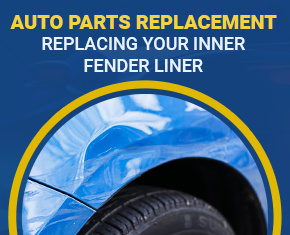Inner fender liners guard against corrosion and other types of damage to the wheel well and car body. The fender liner on front-wheel-drive cars also serves as a splash screen, preventing water from causing belt slippage whenever driving in heavy rain or over large puddles.
They are often constructed of thermoplastic or even other non-corrosive, flexible, and long-lasting materials. Amongst each front wheel and the fender, most cars feature inner fender liners. However, in certain automobiles, they may also be seen on the rear wheels.
When Should You Replace Your Fender Liners?
When you observe any of the following signs, it’s time to look for a Fender liner replacement:
Damaged wheel well, fender, & internal component
Wheel wells and fenders are subject to damage in a collision. After an incident that reshapes the wheel & its inside components and panels, it is necessary to replace the inner fender liner.
Damaged, cracked, or chipped inner fender lining
It’s worth mentioning that Fender liners are rarely chipped. They are designed to surrender when hit by anything that may chip them.
The position of the Fender liner is not the only aspect that adds to its vulnerability to damage. Its substance also has an impact on its durability.
Inner fender liners of older and vintage automobiles are constructed of metal, such as aluminum or steel. These inner fender liners are prone to rust and should ideally be replaced with non-corrosive materials.
Meanwhile, modern vehicles come equipped with ABS plastic & thermoplastic inner fender liners. This reduces the likelihood of corrosion damage.
ABS plastic is heat, abrasion, & impact resistant, as well as reasonably priced. It is, however, prone to wear with time and is not totally chemical-resistant.
In the meanwhile, thermoplastic is a polymer that can be melted and recast. This material is widely known for its corrosion and chemical resistance. Because of its flexibility, it is also an excellent insulator and does not chip away easily. The only drawback of thermoplastic is that it reacts to weather changes. It melts in hot weather & hardens in cold weather.
During the winter, inner fender liners, especially those made of thermoplastics, were prone to failure. They may crack, break, or even develop holes as a result of road debris and other objects being tossed around inside the wheel well. It’s time to repair the inner fender liner if it develops visible cracks and abruptly falls off.
Whenever attempting to repair or replace your fender liner, inspect both the fender liner and the wheel well for damage and corrosion. This first evaluation can assist you in estimating the fender liner repair cost. Also, make sure you have new retainers (the correct type and size) for your new Fender liner.
If your fender liner has been damaged for a long period, rust and other damage may have already formed. Prevent unforeseen costs by identifying the amount of damage ahead of time.
If in doubt, ask your technician, who will be able to show you how to remove a fender liner. It will also be capable of assisting you in evaluating the circumstance if you are unsure of the amount of the damage.
How Much Does a Fender Liner Replacement Cost?
The cost of a replacement fender liner is mostly determined by the part’s compatibility with the year, make, and model of your vehicle.
Other factors include brand, material, quantity, and location.
Do You Require Fender Liners?
The basic answer is that you do require a Fender liner. The undercarriage of a vehicle has several moving elements as well as electrical & metal components. Among these components are the wheel well, headlamp electronics, and powertrain components. However, removing all of your fender liners & driving the car that way is unlikely to result in a collision, so it’s better to have them fitted than not have them.
Because of its position, the wheel well is particularly prone to corrosion. If these elements are exposed to caustic, foreign substances, or debris, their particular function may be compromised, lowering the overall performance of the vehicle.
The aim of the inner fender liner is to keep moisture & debris out of the engine bay. It keeps water out of the wires and other electronic components. It also prevents rocks, stones, as well as other debris from entering your car and interfering with its internal workings.
If a broken inner fender liner is not repaired, it can result in more major and costly problems in the long term.
